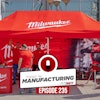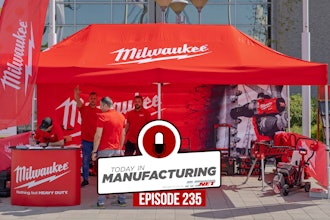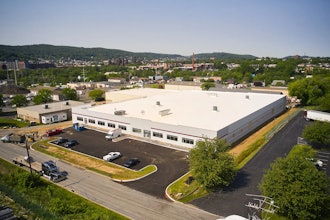Indoor air quality - IAQ - is a common concern for facility managers and occupants in commercial buildings. It has taken on even greater significance in light of the recent anthrax contaminations. For a variety of reasons, however, IAQ is often overlooked in manufacturing environments. As other recent events have shown, such neglect can be dangerous - even lethal - due to the broad array of chemical and process mists and vapors that can be inhaled by workers.
In March 2001, for example, two workers died as a result of complications from Legionnaires' disease, which they reportedly contracted while working at a Ford Motor Co. plant in Cleveland, OH. The bacterium that killed these two workers and infected a handful of other employees is thought to have spread through mist from a contaminated water source at the plant. The plant was forced to shut down for nearly a week after the incident to undergo disinfection and sampling by the Centers for Disease Control.
Similarly, a popcorn factory was faced with a potentially deadly IAQ problem as a result of the chemicals used in the manufacturing process. In October 2001, workers at the Gilster-Mary Lee Corp. in Jasper, MO, contracted a rare lung disease from breathing the vapors of artificial butter flavoring used in the production of microwave popcorn. The irreversible lung disease - called bronchiolitis obliterans - has affected at least eight employees, four of which will require lung transplants. Authorities believe the workers contracted the disease after being exposed to the flavoring as it wafted from large vats used in the manufacturing process.
Despite stories like this, information on IAQ for manufacturing facilities is still hard to come by. But experts are encouraging facility managers and industrial hygienists to learn about IAQ issues in manufacturing environments before it's too late.
"There are some real issues related to IAQ in manufacturing facilities, but unfortunately the priority and emphasis on identifying and controlling them is generally not as great as it is in other areas," says Ed Light, a certified industrial hygienist with Building Dynamics, an Ashton, MD-based consulting group. "But they will affect the health, comfort and safety of production and non-production workers, so something should be done to correct these problems."
Experts say the major concerns should focus on how IAQ for manufacturing plants differs from commercial buildings, how to use engineering and administrative controls to correct existing problems and what measures can be taken to prevent potential IAQ problems.
Industrial IAQ issues
"The main difference between IAQ for manufacturing facilities and commercial buildings is that factories often have mixed-use areas," says Michael Pinto, CEO of Wonder Makers Environmental, Inc., an environmental consulting firm in Kalamazoo, MI. "This means there's usually an office or break room component in a facility where there are also chemicals being used and work processes being conducted. The possibility of chemical or work-in-process contamination getting into these areas makes it potentially dangerous for employees."Another major difference is the type of ventilation system used in a manufacturing environment.
"Commercial buildings tend to be more closely controlled because they use a loop system," explains Eric Schakel, manager of air handling systems with Johns Manville, in Denver, CO. "This means the air is filtered and re-circulated and less outside air is introduced into the building. In many plants, however, ventilation is necessary because of the processes being conducted in the plant. If there are chemicals or particulates in the air, they need to be exhausted. If there are hot or cold manufacturing processes, you need to closely control the content of the air. Both of these factors require more airflow, which means you exhaust a lot of your conditioned air outside. As a result, you must vigilantly control the conditions of the air that you pull back into the plant to make up for that loss."
Complicating this situation is the discharge from the stacks on the roof of manufacturing buildings," says Dave Dyjack, chairman of the department of environmental and occupational health at Loma Linda University School of Public Health in Loma Linda, CA. "This can be a problem if the stacks aren't designed, operated and maintained in a way that prevents the contaminants from being sucked back into the building through the air handling system," he says.
The third major difference between manufacturing facilities and commercial buildings is the presence of potentially noxious equipment, processes and chemicals inside the plant that can cause air pollution and illness.
Added together, these factors can create a recipe for disaster. Ron Johnson, the United Auto Workers health and safety representative at the DaimlerChrysler Kenosha Engine Plant in Kenosha, WI, says it was a combination of several of these factors that caused an outbreak of sensitivity numenitis, a lung disease associated with inhaling oil mist, in the factory three years ago.
"A lot of our heaters were partial air-exchange units and many had gone bad," says Johnson. "When cold weather hit and the windows were closed we had no air exchange whatsoever, so we were a captive audience. This proved to be dangerous in a plant where synthetic oil mixed with water is used as a coolant in the processes we used to machine and grind engine parts."
The combination of the oil mist and poor ventilation system resulted in locations within the plant with air contamination levels as high as 3.2 parts per million (ppm) per cubic meter, which caused the outbreak of the lung disease.
How does a plant correct dangerous IAQ situations like these?
"Industrial hygienists uses a hierarchy of controls when minimizing and correcting IAQ risk factors in the workplace," says Dyjack. "The first method is to employ engineering controls." This includes constructing barriers, performing equipment modifications to control exposures or minimize exposures before they occur, and performing preventive maintenance to equipment and processes that are used in the manufacturing environment.
Engineering controls proved to be the remedy at the Kenosha Engine plant. "We hired an outside consulting firm that helped design encapsulation buildings and enclosures, and designed an airflow system that would collect the mist, run it into a collection area for coalescing, send it back into coolant tanks, filter the air through HEPA filters, and finally reintroduce it into the workplace," says Johnson.
"Along with that project," he adds, "we upgraded the heating and cooling systems in order to have a minimum of 20% air exchange in cold weather and 45% in hot weather." Johnson says the two projects have helped the Kenosha plant reduce pollution to acceptable levels of 0.5 ppm per cubic meter.
"The second major control measure is administrative," says Dyjack. "These include training workers on the practices used to avoid exposure, how to identify hazards, and activities such as biological monitoring and air testing to determine if risk factors are present. Using engineering and administrative controls should be an effective way to eliminate IAQ issues in almost any environment."
IAQ target areas
Even if you don't have a serious IAQ problem, it might be worthwhile to take steps to avoid potential trouble. These fall into several categories: proper planning, equipment modification and good maintenance and housekeeping.Proper planning: "As we design and renovate buildings, we need to make sure we consider IAQ upfront," says consultant Pinto. Things to consider during a renovation include:
• Rooftop stacks. "Stacks and cooling towers should be placed at least 50 ft. away from air intakes," says Dyjack, "and cooling tower stacks should be on the downwind side of the building, so that the prevailing wind will remove excess water droplets, vapor or air contaminants and move them away from the building."
• Separate air handling systems for the manufacturing and administrative areas. "These areas should never share the same HVAC system," says Schakel, "because the requirements for the manufacturing side are totally different than those for the commercial side. The real challenge here lies on the manufacturing side," he says. "You have to define exactly what your processes are so that you get the right type of system."
Equipment modifications: Manufacturing equipment is often designed so that some emissions come off the machines during certain processes. These emissions usually are not a problem because they fall below OSHA-accepted standards. Over time, however, they can impact IAQ in manufacturing facilities. "An illustration of this may be steam or hot water baths used for cleaning parts," says Dyjack. "No one thinks of this as hazardous, but over time that moisture can condensate on porous building materials and mold can begin to grow. This can impact worker health if the mold grows, propagates and becomes airborne."
Methods to eliminate these problems include:
• Use insulation. "The best way to prevent microbial growth from forming due to wet processes or condensation leakage from pipes is insulation," says Ricardo Gamboa, manager of engineering and technical services with Johns Manville. "It can be one of the most effective methods to reduce condensation from chilled water pipes or refrigeration piping in the plant."
• Control vapors through simple modifications. "The most economical way to deal with pollutants getting into occupied manufacturing areas is to reduce the pathway, not control the amount of pollutant," says Light. "To find the most effective way to do this, you have to determine what the pathway is, what kind of ventilation currently exists, and what is the pressure relationship between the affected areas. Very often simple, minor engineering controls can be put in place to reduce the pathway of pollutants."
Preventive measures: It is essential to make sure that good housekeeping and maintenance practices are in place if you want to prevent IAQ problems. Preventive measures include:
• Keeping up with housekeeping duties to make sure mold doesn't have a chance to grow.
• Properly maintaining emission-releasing equipment like forklifts. "If you don't stay on top of fork trucks and keep them tuned up you will get some nasty emissions," says Johnson. "But if you keep them properly maintained, the levels should stay within OSHA guidelines and you won't have a problem."
• Disinfecting and cleaning equipment that releases or holds water vapor or condensation to prevent bacteria from thriving.
• Ensuring your HVAC system is effective and working properly.
Is it time to investigate?
Most IAQ problems are identified by occupant information, which can range from complaining about temperature or odors to an outbreak of illness in one or more areas in the plant. If you are receiving complaints or see a pattern of illness, it's time you looked into the IAQ issues in your plant.There are a number of different formulas you can follow when conducting an IAQ investigation. The Environmental Protection Agency suggests using a system that pinpoints sources of trouble, seeks pathways, then looks for the occupants that could be impacted by the sources. Consultant Pinto suggests looking at five factors - occupant information, visual inspection, inspection of the ventilation and air conditioning systems, possible chemical contaminants and possible biological contaminants - in that order and with the information viewed together to provide a holistic sense of the building.
"If you start with the first three steps, you'll be in a better position to figure out where you will need to collect samples and whether biological or chemical sampling or both are necessary," he says.
Pinto cautions, however, that sampling is often overdone, which can be dangerous because it may replace "intelligent thinking in regards to IAQ investigations." He says, "If people don't know how to conduct an IAQ investigation, they usually take too many samples instead of investigating occupant complaints and performing visual inspections. But if you don't know what you're taking samples of in the first place, you're just generating useless data. A good IAQ investigation will include all the aspects so the investigator gets a sense of what's really going on, not just how high the temperature or chemical contaminants may be."
He adds that high-tech sampling is often not necessary. "I estimate that up to one-half of all IAQ situations could be easily identified and remedied by someone with a good understanding of how to investigate, using low-tech equipment like temperature and humidity probes and carbon-monoxide sampling equipment."
Pinto says an IAQ investigation that follows the right process, and includes occupant interviews and visual inspection is usually the most effective. "If you are direct and look at your facility in a fresh way, chances are you'll be able to handle even the serious complaints," he says.
However, if you do this and get no results, it's time to call in a professional. "If it's been three months and people are still complaining and it's starting to have a psychological impact on the organization, you need to get help," says Pinto. He recommends contacting someone who has experience with IAQ investigations in manufacturing plants with processes like your own.
Because the causes of IAQ problems in manufacturing facilities tend to vary as widely as the processes, Pinto says they need to understand your operation. "If they can't come up with any manufacturing clients with problems or processes similar to yours," says Pinto, "keep looking." Most importantly, he stresses, be prepared to take the necessary steps to ensure your plant provides healthy, breathable air for its workers.
Sidebar
Bad Air, A to ZFollowing is a list of indoor-air-quality pollutants consultant Michael Pinto has been asked to address in recent years. The variety spans nearly the entire alphabet.
Asbestos
Bacteria
Cadmium
De-icer fluid
Internal-combustion exhaust
Fungus
Humidity
Isopropanol (roof mastic)
Jet Fuel
Ketone (caulking compound)
Lead dust (from paint)
Mercury
Ozone/Electrical components
Pesticides
Quercus (oak pollen)
Radon
Sodium Azide
Tobacco smoke
VOCs (paint fumes)
Welding fumes
Xylene
Yeast
Zinc

















